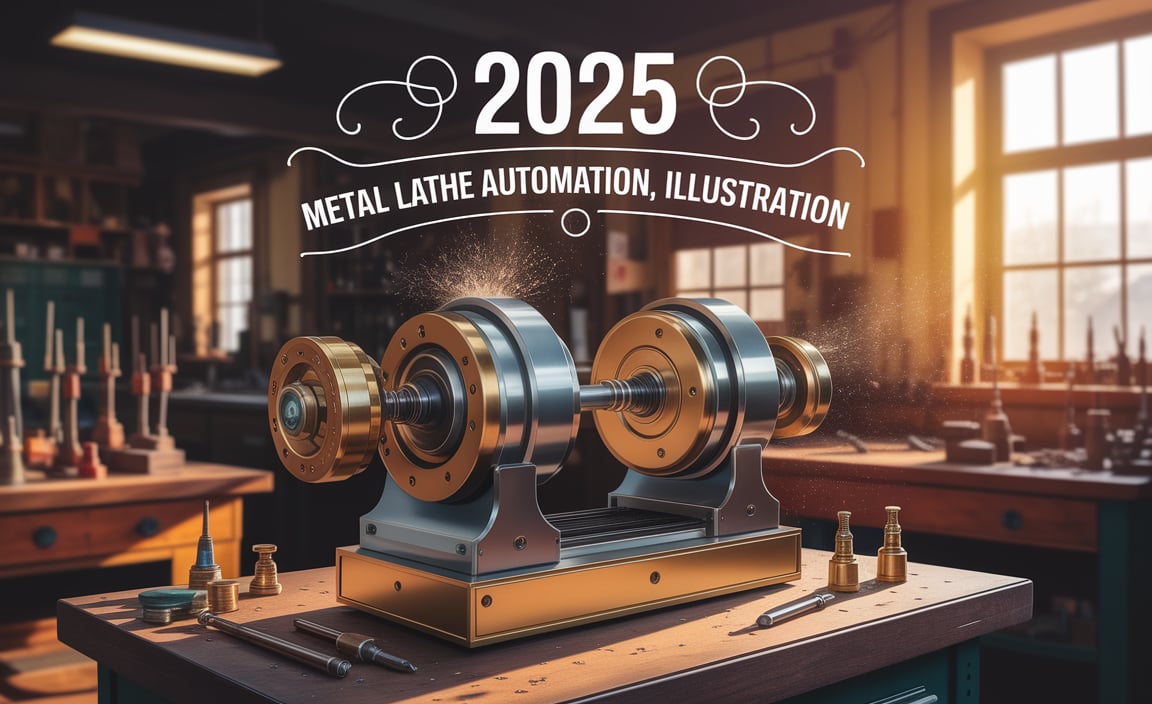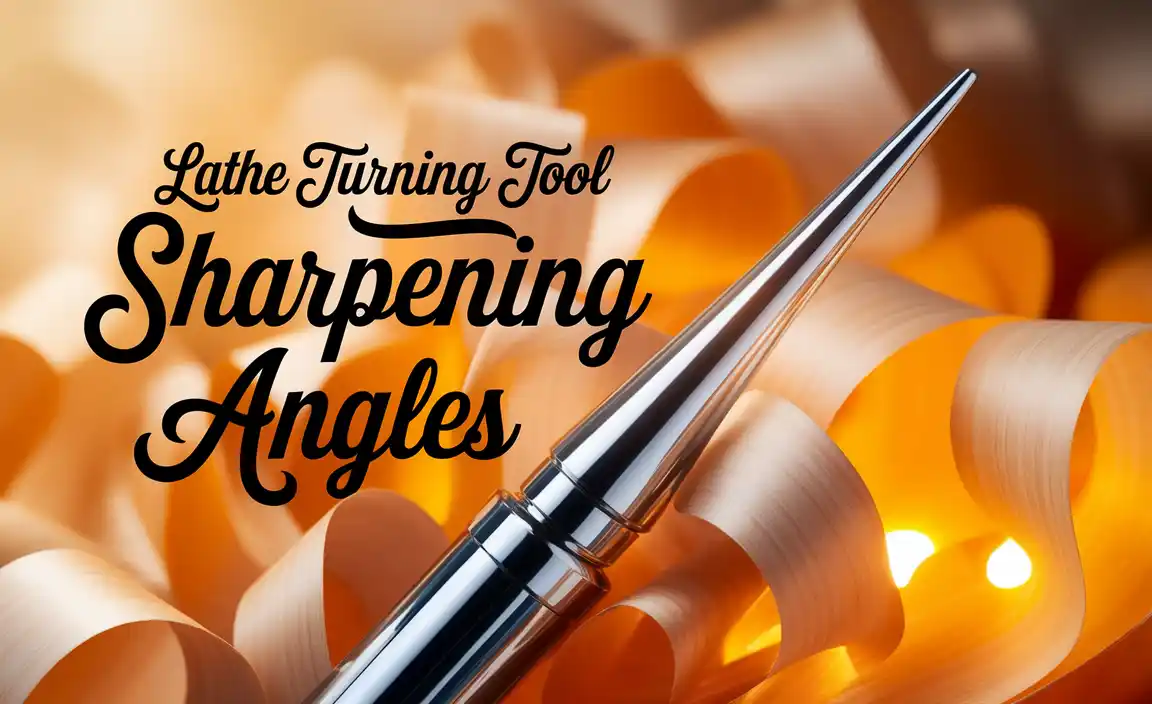Quick Summary:
The TiAlN ball nose end mill with a 40-degree helix angle is a top choice for milling acrylic. It offers excellent heat resistance and sharpness, leading to clean cuts, reduced chipping, and longer tool life, especially for complex shapes and adaptive clearing strategies.
Hey makers! Daniel Bates here from Lathe Hub. If you’ve ever tried to machine acrylic, you know how frustrating it can be. It can melt, chip, and leave a messy edge, especially with the wrong tools. But what if I told you there’s a specific type of end mill that can make a world of difference? Today, we’re diving deep into the world of the TiAlN ball nose end mill with a 40-degree helix angle and why it’s your new best friend for acrylic projects. Let’s get your cuts cleaner and your projects smoother!
Why Acrylic Puts Up a Fight (and How This Tool Helps)
Acrylic, lovable as it is for its clarity and workability, has a bit of a temper when it comes to machining. It has a low melting point, which means heat generated by friction is its biggest enemy. This heat can cause the acrylic to soften and gum up the cutting edges of your end mill. Not only does this lead to poor surface finish, but it can also cause chipping and fracturing of the acrylic itself. Standard end mills may struggle to handle this, leading to frustration and wasted material.
This is where specialized tooling shines. A TiAlN (Titanium Aluminum Nitride) coated ball nose end mill with a 40-degree helix angle is designed to tackle these very challenges. The coating provides a tough, heat-resistant surface, while the specific helix angle helps manage chip evacuation and reduce the tendency for the acrylic to melt. A ball nose geometry is also fantastic for creating smooth, rounded internal corners and contoured surfaces, which are common in many designs.
Understanding the TiAlN Ball Nose End Mill: The Specs
Let’s break down what makes this tool so effective for acrylic. It’s a combination of material, coating, and geometry.
1. The Ball Nose Geometry
A ball nose end mill has a hemispherical tip. This shape is incredibly versatile for several reasons:
- Creating Contours and Radii: Perfect for carving smooth, flowing surfaces and achieving rounded internal corners that a flat-end mill can’t.
- 3D Machining: Essential for detailed surfacing and sculpting in CAD/CAM software.
- Reduced Stress Concentration: The rounded tip distributes cutting forces more evenly, which can be helpful in preventing material stress and fracturing, especially in brittle materials like acrylic.
2. The 40-Degree Helix Angle
The helix angle refers to the angle of the flutes around the tool. For acrylic, a 40-degree helix angle is often a sweet spot:
- Effective Chip Evacuation: A steeper helix angle (like 40 degrees compared to a very shallow one) helps to lift and move chips away from the cutting zone more efficiently. This is crucial for acrylic to prevent melting and recutting chips.
- Reduced Cutting Force: While not as aggressive as a very high helix, a 40-degree angle offers a good balance, providing enough cutting action without generating excessive heat or vibration.
- Smoother Finish: It contributes to a cleaner cut by reducing the tendency for chatter.
3. The TiAlN Coating (Titanium Aluminum Nitride)
This is where the real magic happens for tough materials and high-temperature applications:
- Exceptional Hardness: TiAlN coatings are very hard, which means they resist wear and maintain a sharp cutting edge for longer.
- High Heat Resistance: This is vital for acrylic. The coating acts as a barrier, preventing heat from transferring directly to the tool’s substrate. It creates a thermal barrier, allowing the coating to withstand much higher temperatures than uncoated or even other coated tools.
- Reduced Friction: The dense, smooth coating also helps to reduce friction between the tool and the workpiece, further minimizing heat buildup and preventing material buildup (like melted plastic) on the cutting edges.
- Extended Tool Life: Because it stays sharper for longer and resists wear and heat, a TiAlN coated end mill will last significantly longer when cutting materials like acrylic.
When to Use Your TiAlN 40-Degree Ball Nose End Mill for Acrylic
This specialized tool isn’t just for any acrylic job, but it excels in specific scenarios:
Adaptive Clearing Strategies
Adaptive clearing is a high-speed machining (HSM) technique where the toolpath constantly adjusts to maintain a consistent chip load and engagement with the material. This approach is highly efficient and leads to reduced cycle times and less heat generation. The TiAlN ball nose end mill is ideal for adaptive clearing in acrylic because its geometry and coating can handle the continuous, high-speed engagement required. The balanced cutting action of the 40-degree helix helps manage chip formation during these aggressive toolpaths.
For more on adaptive clearing, check out this resource from CNCCookbook which offers a great explanation of the principles.
Complex 3D Contours and Sculpting
If your project involves intricate curves, rounded features, or detailed 3D sculpting, a ball nose end mill is essential. The TiAlN coating ensures that even during long, complex surfacing passes, the tool remains sharp and doesn’t overheat, preventing the acrylic from melting and ruining your detailed work.
Finishing Passes
For achieving a superior surface finish on acrylic, especially after roughing, this end mill can be used for a finishing pass. Its ability to cut cleanly with minimal heat buildup will leave a smooth, almost polished edge.
When Cutting Thicker Acrylic
Thicker sheets of acrylic present a greater challenge due to the increased volume of material being removed and the potential for heat to build up within the workpiece. The TiAlN coated end mill’s ability to withstand heat and effectively evacuate chips makes it a robust choice for these more demanding cuts.
Setting Up for Success: Parameters and Best Practices
Using the right tool is only half the battle. Proper setup and cutting parameters are crucial for getting the best results from your TiAlN 40-degree ball nose end mill when cutting acrylic. Here’s what you need to consider:
Speeds and Feeds (The Golden Rules)
This is perhaps the most critical aspect. Cutting acrylic too fast or too slow can lead to melting or chipping. While specific numbers vary based on your machine, the specific acrylic type, and the end mill diameter, here are general guidelines:
- Spindle Speed (RPM): Generally, it’s better to run acrylic at moderate to higher RPMs. This allows the tool to cut efficiently rather than rub. Start in the range of 10,000 – 25,000 RPM, depending on tool diameter and machine capability.
- Feed Rate: This is crucial for chip load. You want to remove material efficiently to prevent heat buildup but avoid overloading the tool. A good starting point for a 1/8″ (3mm) end mill might be around 20-40 inches per minute (ipm) or 500-1000 mm/min. For larger tools, you’ll increase this. The goal is to produce small, clean chips, not fine dust or melting plastic.
- Chip Load: This refers to the thickness of the chip each tooth of the end mill removes. A good chip load for acrylic with this type of end mill is typically between 0.001″ and 0.004″ (0.025mm to 0.1mm).
- Depth of Cut (DOC): For general machining, a shallower DOC is often better. Around 0.010″ to 0.050″ (0.25mm to 1.25mm) is a good starting range. For roughing, you might go deeper, but always monitor for heat and chip formation.
- Stepover: This is the distance the tool moves sideways between passes. For finishing, a small stepover (e.g., 10-20% of tool diameter) is used for a smooth surface. For adaptive clearing, the software manages this.
Important Note: Always start with conservative settings and progressively increase them while monitoring the cut. Listen to the machine, watch the chips, and feel the workpiece (carefully!). If you see melting, increase your feed rate or adjust your depth of cut. If you hear chatter, you might need to adjust speed or feed.
Cooling and Lubrication
While TiAlN coating helps immensely, some form of cooling or lubrication can still be beneficial, especially for long cuts or thicker materials.
- Air Blast: A simple blast of compressed air directed at the cutting zone is often sufficient to blow chips away and keep temperatures down.
- Coolant Mist: A mist coolant system can provide substantial cooling and lubrication. Use a coolant specifically designed for plastics if possible, or a light, non-oily general-purpose coolant.
- Avoid Flood Coolant: For acrylic, flood coolant can sometimes cause issues with fixturing or post-processing cleanup. Air or mist is usually preferred.
Reference the material safety data sheet (MSDS) for your specific acrylic for any recommended machining practices from the manufacturer. For general machining safety, OSHA provides valuable guidelines.
Fixturing Your Acrylic
Secure fixturing is paramount for any machining operation and especially important for plastics. Acrylic can be prone to vibration and movement if not properly secured, leading to poor cuts and potential hazards.
- Use a Fixture or Jig: Whenever possible, clamp your acrylic to a spoilboard or a dedicated fixture.
- Even Pressure: Distribute your clamping pressure to avoid deforming the acrylic, which can lead to inaccuracies.
- Sacrificial Board: Machining directly onto a sacrificial board (like MDF) beneath the acrylic can help protect your machine bed and provide a stable surface.
Toolpath Strategy
The software you use for your CNC machine (CAM software) plays a big role. For acrylic, especially with a ball nose end mill, consider:
- Climb Milling: Generally preferred for a smoother finish and reduced cutting forces.
- Rest Machining: If you’ve done a roughing pass, use rest machining to clear out areas that the larger roughing tool couldn’t reach.
- Optimize for Ball Nose: Ensure your CAM software is set up to utilize the ball nose geometry effectively for curves and radiused features.
Comparing Cutting Strategies for Acrylic
Let’s look at how different strategies fare with acrylic and where our TiAlN ball nose end mill fits in.
1. Standard Pocketing vs. Adaptive Clearing
Standard Pocketing: This involves traditional toolpaths that might enter and exit pockets repeatedly, sometimes with inefficient movement. It can generate more focused heat in specific areas with each pass and has a higher potential for chipping if not carefully programmed.
Adaptive Clearing: As we’ve discussed, this method maintains a consistent tool engagement, leading to smoother cutting, better heat dissipation, and reduced stress on the tool and workpiece. Our TiAlN 40-degree ball nose end mill is perfectly suited for this, allowing for more aggressive material removal while keeping temperatures manageable and preventing melting.
2. Roughing vs. Finishing
Roughing: This is about removing bulk material quickly. While you might use a standard end mill for acrylic roughing, taking aggressive cuts can still lead to material buildup or melting. A TiAlN coated tool, even for roughing, will resist wear better.
Finishing: This is where the ball nose geometry and sharp TiAlN coating truly shine. It’s used for the final passes to achieve that smooth, pristine surface finish that acrylic is known for. The specific 40-degree helix helps ensure clean cuts without snagging.
3. Different Ball Nose Angles
While we’re focusing on 40 degrees, it’s good to know there are others:
- 15-30 Degree Helix: These steeper angles can offer even more aggressive chip evacuation but might be more prone to chatter on some machines.
- 90 Degree Ball Nose (0 Degree Helix): These are rare but essentially have no twist. Not ideal for most acrylic machining.
- Ball Nose with No Helix (Square End Mill): While not a true ball nose, some end mills might have a very low helix.
The 40-degree angle strikes a fantastic balance for acrylic, providing good chip evacuation without sacrificing too much rigidity compared to very steep helix angles.
Troubleshooting Common Acrylic Machining Issues
Even with the right tool, you might encounter hiccups. Here are common problems and how our TiAlN end mill can help resolve them:
Issue: Acrylic Melting/Gumming Up
Cause: Too much heat, not enough chip load, slow feed rates, or poor chip evacuation.
Solution: This is exactly what the TiAlN coating fights against! Ensure you are using adequate spindle speed, a proper feed rate (to create chips, not dust), and a shallow enough depth of cut. The 40-degree helix helps clear chips. Consider an air blast or mist coolant.
Issue: Chipping or Cracking
Cause: Brittle material, too much force, vibration, or cutting edge chipping away material.
Solution: Use a sharp tool (the TiAlN coating helps maintain sharpness). Ensure your acrylic is securely fixtured to minimize vibration. A smooth, consistent cut from the ball nose geometry, combined with appropriate speeds and feeds, will reduce stress. Avoid plunging too aggressively if possible.
Issue: Poor Surface Finish
Cause: Dull tool, incorrect speeds/feeds, shallow helix angle, or re-cutting chips.
Solution: The TiAlN ball nose end mill is your best bet for a great finish. Ensure your CAM software is set for finishing passes with an appropriate stepover. Double-check your speeds and feeds; a slightly higher feed rate can sometimes improve finish by ensuring a cleaner cut.
Issue: Tool Breakage
Cause: Excessive force, sudden stops/starts, incorrect plunge moves, or a weak tool/holding setup.
Solution: Ensure your end mill is properly seated in your collet. Avoid aggressive plunges; use the CAM software’s plunge ramping features if possible. The TiAlN coating adds toughness, but proper machining practices are still key. Make sure your machine’s rigidity is adequate for the forces involved.
Table: TiAlN Ball Nose End Mill Applications for Acrylic
Here’s a quick reference for when this tool is your go-to:
| Application/Feature | Benefit of TiAlN 40° Ball Nose End Mill | Notes |
|---|---|---|
| Complex 3D Contouring | Smooth, flowing surfaces, reduced melting, maintains detail. | Ideal for artistic or intricate designs. |
| Adaptive Clearing | Efficient material removal, controlled heat, long tool life. | Requires CAM software capable of adaptive toolpaths. |
| Internal Radii & Fillets | Creates perfect rounded internal corners. | Ball nose geometry is essential for these features. |
| Finishing Passes | Achieves a high-quality, polished surface finish. | Use a fine stepover for best results. |
| Thicker Acrylic Sheets | Withstands higher cutting forces and heat better. | Careful parameter tuning is key. |
| High-Volume Production | Extended tool life means less downtime for tool changes. | Good for workshops making multiple parts. |
Frequently Asked Questions (FAQ)
Q1: Can I use a TiAlN ball nose end mill for plastic in general, not just acrylic?
A: Yes, generally! TiAlN coatings are excellent for a wide range of plastics and non-ferrous metals. Their heat resistance and hardness make them suitable for materials prone to melting or wear, such as polycarbonate, ABS, and even softer metals like aluminum. Always check manufacturer recommendations for specific materials.
Q2: How do I clean melted acrylic off my end mill?
A: If the acrylic hasn’t baked on too hard, try a plastic cleaner or a solvent like isopropyl alcohol. For tougher buildup, a brass brush can sometimes work, but be gentle. Often, if it’s severely melted on, the coating might be compromised, and it’s best to consider replacing the tool to ensure optimal performance and avoid damaging your workpiece.







